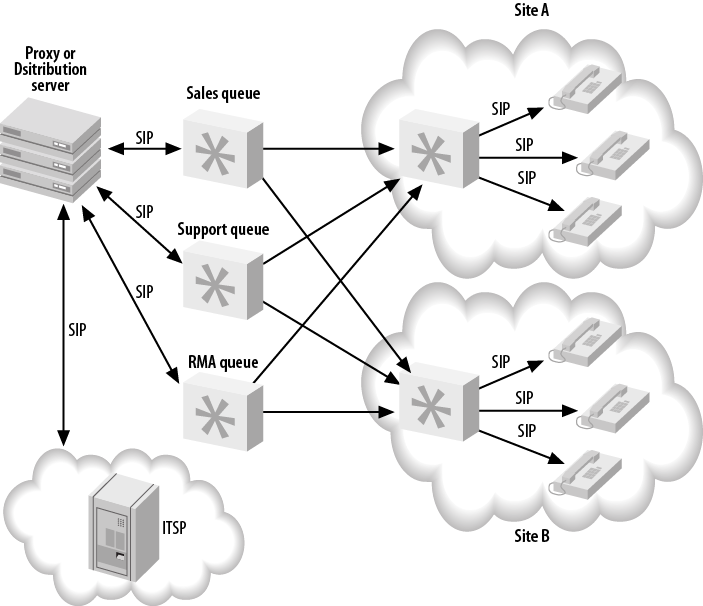Now, let’s get creative and use the various tools we’ve discussed in the previous sections to build a distributed queue infrastructure. Figure 22.8, “Distributed queue infrastructure” illustrates a sample setup where we have five Asterisk servers being fronted by another cluster used to distribute/route the calls to the various queues we have set up. Our ITSP sends calls to the routing cluster (which could be something like Kamailio, or even multiple Asterisk servers implementing DUNDi or some other method to route and distribute calls), which then sends the calls as appropriate to one of the three Asterisk systems we have our queues configured on. Each server handles a different queue, such as sales, technical support, and returns. These servers in turn use the agents located at two separate physical locations. The agents’ devices are registered to their own local registration servers (which may also perform other functionality).
Note
We are not showing all aspects of the system, in order to keep the diagram simple, but in this case we would be using the XMPP distributed device state system as we’re implying that the agents are distributed across multiple physical sites.
All of the agents at the different locations can be loaded into one or more queues, and because we’re distributing device state information, each queue will know the current state of the agents in the queue and will only distribute callers to the agents as appropriate. Beyond that, we can configure penalties for the queues and/or for the agents in order to get the callers to the best agents if they are available, and only use the other agents when all the best agents are in use (for more information on penalties and priorities, refer to the section called “Advanced Queues”).
We can add more agents to the system by adding more servers to the cluster at either the same location or additional physical locations. We can also expand the number of queues we support by adding more servers, each handling a different queue or queues.
A disadvantage to using this system is the way the
Queue() application has been developed. Queue() is one of the
older applications in Asterisk, and it has unfortunately not kept up with
the pace of development in the realm of device state distribution, so
there is no way to distribute the same Queue() across
multiple boxes. For example, suppose you have sales queues on two systems.
If a caller enters the sales queue on the first Asterisk system, and then
another caller enters the sales queue on box two, no information will be
distributed between those queues to indicate who is first and who is
second in line. The two queues are effectively separate. Perhaps future
versions of Asterisk will have the
ability to do that, but at this time it is not supported. We mention this
so you can plan your system accordingly.
Since queues in some implementations (such as call centers) may be required to handle many calls at once, the processing and load requirements for a single system can be quite steep. Having the ability to tap into the same agent resources across multiple systems means that we can distribute our callers among multiple boxes, significantly lowering the processing requirements placed on any single system. No longer does one system need to do it all—we can break out various components of the system into different servers.
